
Catania is the second-largest municipality in Sicily, after Palermo, both by area and by population. Despite its reputation as the second city of the island, Catania is the largest Sicilian conurbation, and among the largest in Italy. It has important road and rail transport infrastructures, and hosts the main airport in Sicily. The city is located on Sicily's east coast, facing the Ionian Sea at the base of the active volcano Mount Etna. It is the capital of the 58-municipality region known as the Metropolitan City of Catania, which is the seventh-largest metropolitan area in Italy. The population of the city proper is 311,584, while the population of the Metropolitan City of Catania is 1,107,702.
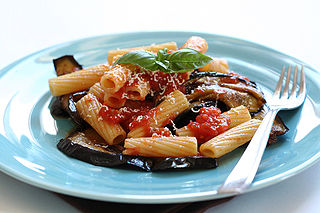
Sicilian cuisine is the style of cooking on the island of Sicily. It shows traces of all cultures that have existed on the island of Sicily over the last two millennia. Although its cuisine has much in common with Italian cuisine, Sicilian food also has Greek, Spanish, French, Jewish, Maghrebi, and Arab influences.

Caltagirone is an inland city and municipality in the Metropolitan City of Catania, on the island of Sicily, Southern Italy, about 70 kilometres (43 mi) southwest of Catania.

Paternò is a comune (municipality) in the Metropolitan City of Catania, in the Italian region of Sicily. With a population (2016) of 48,009, it is the third municipality of the province after Catania and Acireale.
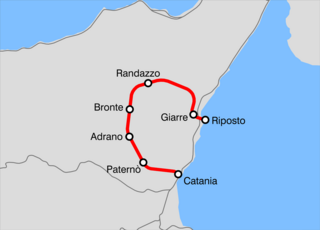
The Ferrovia Circumetnea is a narrow-gauge, 950 mm, regional railway line in Sicily. It was constructed between 1895 and 1898.

Centuripe is a town and comune in the province of Enna. The city is 61 kilometres (38 mi) from Enna in the hill country between the Rivers Dittaìno and Salso.

Biancavilla is a town and comune in the Metropolitan City of Catania, Sicily, southern Italy. It is located between the towns of Adrano and S. Maria di Licodia, 32 kilometres (20 mi) northwest of Catania. The town was founded and historically inhabited by the Arbëreshë community.

Randazzo is a town and comune in the Metropolitan City of Catania, Sicily, southern Italy. It is situated at the northern foot of Mount Etna, c. 70 kilometres (43 mi) northwest of Catania. It is the nearest town to the summit of Etna, and is one of the points from which the ascent may be made.

Belpasso is a comune (municipality) in the Metropolitan City of Catania in the Italian region Sicily, located about 150 kilometres (93 mi) southeast of Palermo and about 10 kilometres (6 mi) northwest of Catania. Belpasso is the second biggest comune of the Catania's area for area.
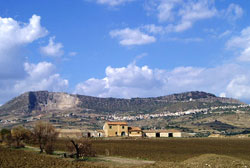
Castel di Iudica is a comune (municipality) in the Metropolitan City of Catania in the Italian region Sicily, located about 130 kilometres (81 mi) southeast of Palermo and about 35 kilometres (22 mi) west of Catania.

Castiglione di Sicilia is a comune (municipality) in the Metropolitan City of Catania in Sicily, southern Italy. It is one of I Borghi più belli d'Italia.

Maletto is a comune (municipality) in the Metropolitan City of Catania in the Italian region Sicily, located about 140 kilometres (87 mi) east of Palermo and about 40 kilometres (25 mi) northwest of Catania.

Nicolosi is a comune (municipality) in the Metropolitan City of Catania in the Italian region Sicily, located about 160 kilometres (99 mi) southeast of Palermo and about 12 kilometres (7 mi) northwest of Catania.
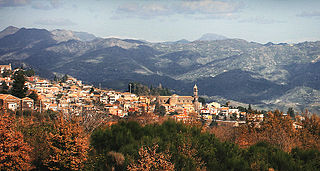
Saint Alphys or is a comune (municipality) in the Metropolitan City of Catania in the Italian region Sicily, about 160 kilometres (99 mi) east of Palermo and about 25 kilometres (16 mi) north of Catania.
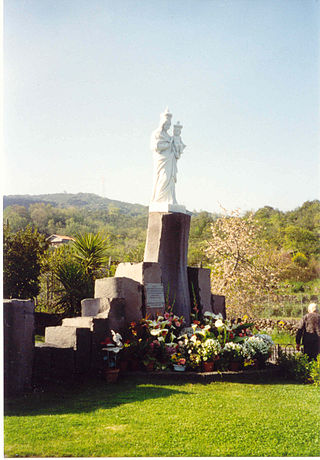
Zafferana Etnea is a comune (municipality) in the Metropolitan City of Catania in the Italian region Sicily, located about 160 kilometres (99 mi) southeast of Palermo and about 20 kilometres (12 mi) north of Catania.

Aetna, was an ancient city of Magna Graecia in Sicily, situated at the foot of the mountain of the same name, on its southern declivity. It was originally a Sicelian city, and was called Inessa or Inessum.

The Battle of Centuripe was fought from 2 to 4 August 1943, as part of the Allied invasion of Sicily during World War II. The 78th Battleaxe Division, of the British Eighth Army, was engaged in fierce fighting around the town of Centuripe in the central portion of Sicily in the hill country between the Rivers Dittaìno and Salso. Centuripe, a hill town set on a very high rocky pinnacle and approached by only one steep and twisty road, itself was the key to the whole Adrano position, the capture of which would in turn force the Germans to withdraw to new positions. The British troops captured the town after heavy fighting and as a result caused the Germans to start contemplating abandoning Sicily altogether.

The Metropolitan City of Catania is a metropolitan city in Sicily, southern Italy. Its capital is the city of Catania. It replaced the province of Catania and comprises the city of Catania and other 57 comuni.
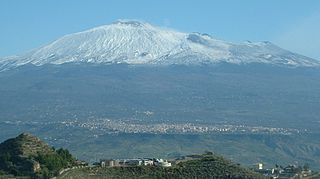
Adranon or Adranos, present day Adrano, was an ancient polis of Magna Graecia on the southwestern slopes of Mount Etna, near Simeto River.

The church of the Abbey of San Filippo d'Agira is located in Piazza Abbazia #1 in the town of Agira, province of Enna, region of Sicily, Italy. It is also referred to as the Reale Abbazia or royal abbey.


























